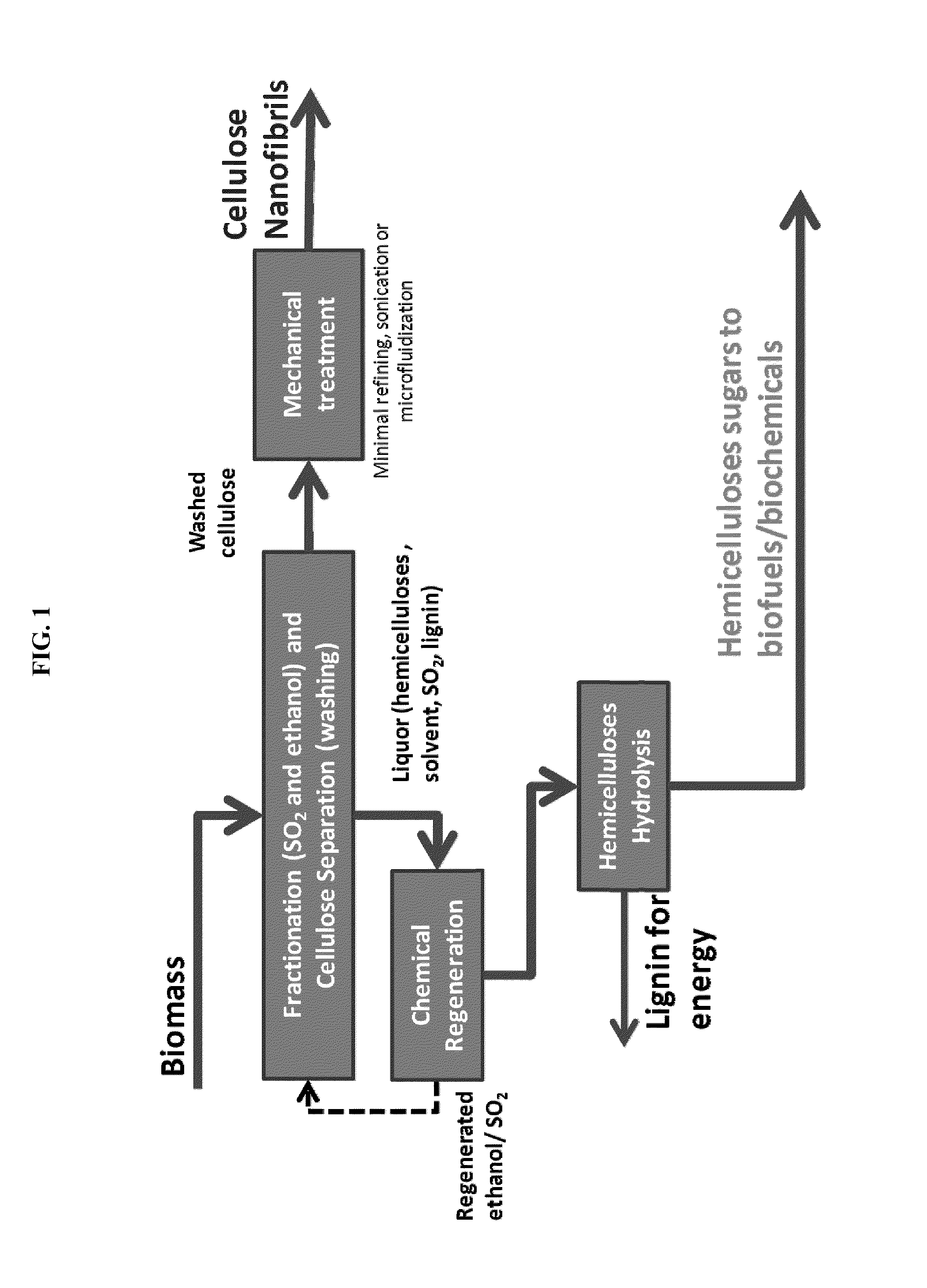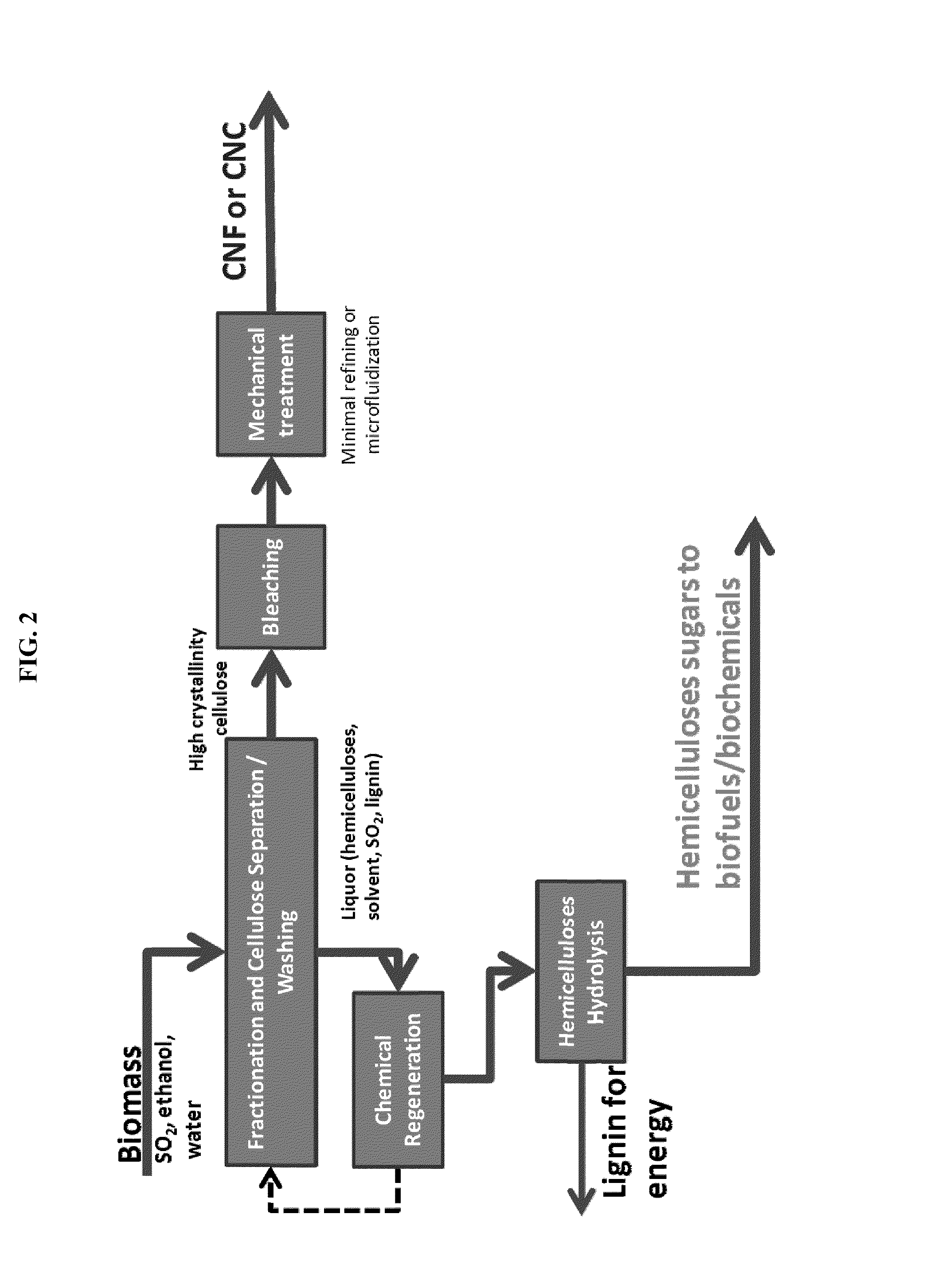Processes and apparatus for producing nanocellulose, and compositions and products produced therefrom
a technology of nanocellulose and process equipment, applied in the field of nanocellulose, can solve the problems of high energy consumption, damage to fibers and particles, and high energy consumption
- Summary
- Abstract
- Description
- Claims
- Application Information
AI Technical Summary
Benefits of technology
Problems solved by technology
Method used
Image
Examples
example 1
Production of Cellulose Nanofibrils and Cellulose Nanocrystals
[0285]Eucalyptus chips (30 wet grams; 46 wt % moisture) were cooked in a 250-mL reactor in a hot oil bath with 12 wt % SO2, 56 wt % ethanol, and a liquor-to-biomass ratio of 6. The fractionation chemicals solution was composed of 49.2 g 95 wt % ethanol solution, 23.5 g distilled water, and 10.4 g SO2. Time and temperature were varied to study the effect on degree of polymerization, particle morphology, and mechanical energy consumption for the final fibrillization step.
[0286]The following conditions were studied:
[0287]Fractionation temperature 145° C., fractionation time 45 min
[0288]Fractionation temperature 145° C., fractionation time 60 min
[0289]Fractionation temperature 165° C., fractionation time 15 min
[0290]Fractionation temperature 165° C., fractionation time 30 min
[0291]Fractionation temperature 165° C., fractionation time 45 min
[0292]Fractionation temperature 165° C., fractionation time 60 min
[0293]Fractionation t...
example 2
Production of Nanocellulose Materials from Softwood
[0303]Fractionation of softwood is carried out at 165° C. for 60 minutes, with 12 wt % SO2, 56 wt % ethanol, and a liquor-to-biomass ratio of 6. Mechanical treatment includes ultrasonication for 10 minutes at 360 W, to generate nanocellulose. The crystallinity of the cellulose-rich solids is estimated to be 86%. The crystallinity of the nanocellulose is estimated to be 86%, showing high crystallinity of both the precursor material and the nanocellulose, and little or no loss of crystallinity during mechanical treatment. The nanocellulose particles are characterized by an average width of about 20 nm and length range from about 300 nm about 1000 nm or more.
example 3
Production of Nanocellulose Materials from Sugarcane Straw
[0304]Fractionation of sugarcane straw is carried out at 165° C. for 60 minutes, with 12 wt % SO2, 56 wt % ethanol, and a liquor-to-biomass ratio of 6. Mechanical treatment includes ultrasonication for 10 minutes at 360 W, to generate nanocellulose. The crystallinity of the cellulose-rich solids is estimated to be above 80%. The crystallinity of the nanocellulose is estimated to be above 80%, showing high crystallinity of both the precursor material and the nanocellulose, and little or no loss of crystallinity during mechanical treatment. The nanocellulose particles are characterized by an average width of about 20 nm and length range from about 300 nm about 1000 nm or more.
PUM
| Property | Measurement | Unit |
|---|---|---|
| Temperature | aaaaa | aaaaa |
| Temperature | aaaaa | aaaaa |
| Temperature | aaaaa | aaaaa |
Abstract
Description
Claims
Application Information
 Login to View More
Login to View More - R&D
- Intellectual Property
- Life Sciences
- Materials
- Tech Scout
- Unparalleled Data Quality
- Higher Quality Content
- 60% Fewer Hallucinations
Browse by: Latest US Patents, China's latest patents, Technical Efficacy Thesaurus, Application Domain, Technology Topic, Popular Technical Reports.
© 2025 PatSnap. All rights reserved.Legal|Privacy policy|Modern Slavery Act Transparency Statement|Sitemap|About US| Contact US: help@patsnap.com



